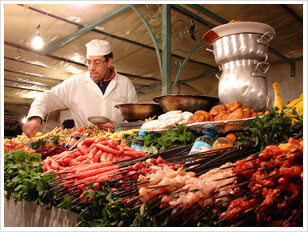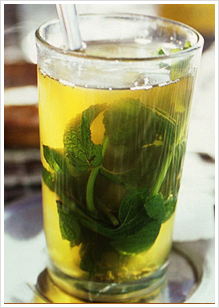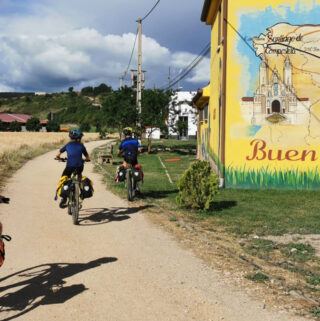Moroccan cuisine is a very diverse cuisine, with a large number of influences due to the interaction of Morocco with the outside world for centuries. The cuisine of Morocco is a mix of Arab, Berber, Moorish, Middle Eastern, Mediterranean and African influences.
Spices are used extensively in Moroccan food. While spices have been imported to Morocco for thousands of years, many ingredients, like saffron from Tiliouine, mint and olives from Meknes and oranges and lemons from Fez, are home-grown.
The structure of meals in Morocco is quite interesting. The midday meal is the main meal, with the exception of the holy month of Ramadan. The typical meal begins with a series of hot and cold salads, followed by a tagine.
Tagines in Moroccan cuisine are slow-cooked stews braised at low temperatures, resulting in tender meat with aromatic vegetables and sauce. They are traditionally cooked in the tagine pot, whose cover has a knob-like handle at its top to facilitate removal.
Bread is eaten with every meal – Moroccans almost always eat with their hands and use bread as a utensil.
Often, for a formal meal, a lamb or chicken dish is next, followed by couscous topped with meat and vegetables. A cup of sweet mint tea is commonly used to end the meal.
Beef is the most commonly eaten red meat in Morocco. Lamb is preferred, but is not as common due to its higher cost. The breed of sheep in North Africa has much of its fat concentrated in its tail, which means that Moroccan lamb does not have the pungent flavour that Western lamb and mutton can have. Poultry was historically used and the importance of seafood is increasing in Moroccan food.
Sweets are not usually served at the end of a Moroccan meal – sasonal fruits are typically served instead. However pastries are very popular – such as kaab el ghzal, which means gazelle’s horns and is a pastry stuffed with almond paste and topped with sugar.
The most popular drink is of course green tea with mint. Traditionally, making good mint tea in Morocco is considered an art form and the drinking of it with friends and family members is one of the important rituals of the day. The technique of pouring the tea is as crucial as the quality of the tea.
Reference: Wikipedia







I so love Moroccan food!